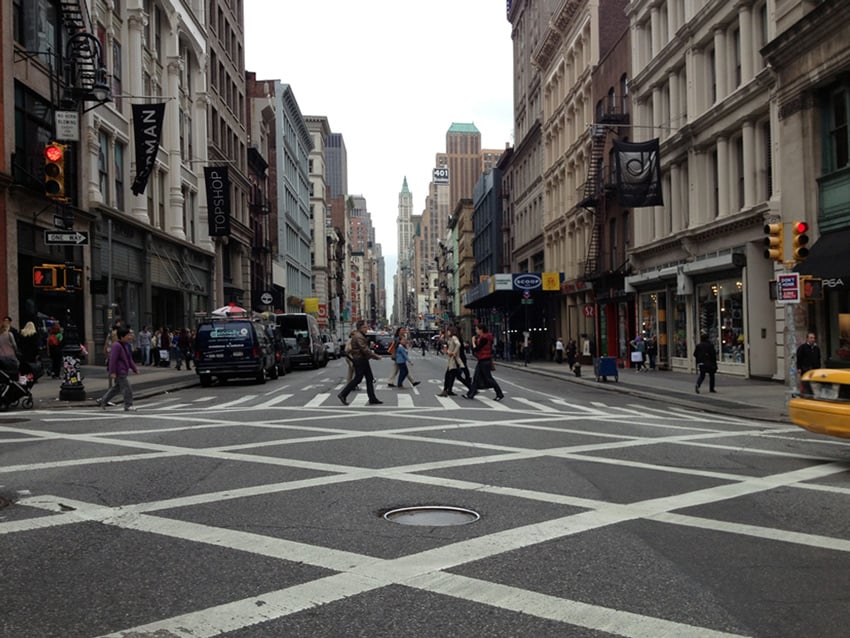Gray Man Strategies 101: Peeling Away the Thin Veneer of Society
Gray Man Strategies 101: Peeling Away the Thin Veneer of Society

Moving through the city during a “loss of civility” (government-speak for breakdown) can be extremely dangerous, even life-threatening. Sadly, there will be many predators who wait for just such occasions to prey upon those whom they perceive as weak. We call them “opportunivores.” Opportunivores only obey laws because they fear punishment. When law enforcement is removed from the equation, opportunivores become a law unto themselves.
Avoiding these predators may require different strategies. One is to move in a large enough force, and to be threatening enough, that the predators move on to easier targets. Another is to move when the predators are not vigilant. A third and more flexible method, is to learn to blend into a crowd and not do anything to draw attention to oneself.
Blending into a crowd is called becoming a gray man.
There are people moving around us every day whose physical presence is so non-stimulating that we ignore them. They are for all intents and purposes, invisible to us. The gray man is the one we want to emulate in a disaster. The problem is, people have never seen a true gray man, unless you’ve been taught to see them. Because if you casually noticed him, his gray man-ness is in dispute.
So who is the gray man and how do we find and emulate him? It will require some time observing crowds of people. The process is based on an understanding of how your mind remembers what it sees.
RAS (Reticular Activating System)
The principle is simple. The mind remembers whatever significantly stimulates it. If there is no stimulus, there is no noticing. Breaking this idea down further, the brain contains a filter for all sensory input called the Reticular Activating System. It’s a part of the brain that filters sensory data. For example, your eyes send a complete stream of data down the optic nerve. The RAS scans that feed and determines what parts of the process to filter and what parts to pay attention to. This allows the brain to conserve energy by not having to process all the visual data.
What does the RAS filter and what does it send through?
The brain is looking for first, threats. The RAS will send data related to fast movement, threatening movement, movement on vectors that will intercept your own. It also looks for bright colors, human shapes, reflections, bright light, implied movement and other similar things that STIMULATE the brain. The RAS ignores areas of continuous color, shadow, dull, natural colors, slow movement and off vector movement.
The RAS is a very effective movement for sound input as well. It filters sounds that are unnecessary for us to notice, such as the sound of the refrigerator running, but alerts us to sounds that may represent a threat, such as the sound of someone trying to jimmy a window at night.
I have a friend that lives in New York city. I was on the phone with him one day and just outside, an ambulance went by on his end. The sound of the siren via the phone, was incredibly loud in my ears. I interrupted him and told him to wait till the ambulance went by. He said,”What ambulance?” The sound of the ambulance was so common that he filtered it out completely.
So what does the RAS have to do with being the gray man? Simply this. To make yourself invisible to predators, don’t trip their triggers. If you do not create a stimulus that the predator keys in on, you are invisible to him. Just like my friend who could not hear the ambulance, a gray man moves around our awareness without triggering any alarms.
The Art of Blending
How is this accomplished? It seems simple enough. Just blend in. But there is actually quite an art form to this.
Size
Height is an element of being a gray man that we have little control over. The best gray man is ordinary in every respect. He’s of average height and weight. He has no obvious physical features that draw attention, ie, big nose, bald head, facial hair, etc. For example, I have a very hard time being a gray man because I am a big man. I am 6’2” and “husky,” as they say. People remember me as “that big dude.”
Dress
Dress is an element within our control. For the most part, natural and neutral colors work best; Browns and grays. Nothing to create a memory like a T-shirt with a saying or photos. Style of clothing tends to be very conservative. Nothing showing skin, nothing too fashionable, nothing to out of fashion. Ordinary is the key word here.
The standard “uniform” for military’s civilian wear consist of 5.11 Tactical pants, (referred to by some of my friends as “shoot me first pants),” a khaki cotton button-down shirt with epaulettes, Oakley shades, desert combat boots, and a shaved head. Add to that a nice MOLLE backpack, and you have target written all over you. No one doubts that you have some very cool gear in that pack and they will want it. But as cool as that looks, it will draw the attention of both LE and predators.
Mannerisms
Since the gray man attracts no attention, his mannerisms must be small and discreet. No sweeping gestures. Energetically, the gray man is withdrawn. He does not project confidence. He does not look around much, he avoids eye contact.
I stood with a friend on the top level of the Galleria mall observing a class exercise involving foot surveillance. He nudged me and pointed to a guy on the escalator, “Fed!” I asked how he knew the guy was a federal agent. He told me to watch where he looked, what he looked at. Very discreetly, the man in question turned his body to the left and did an almost imperceptible head sweep that allowed him to see behind him. Then he did an adjustment that allowed him to sweep the area on his right. Without having it pointed out to me, I probably would not have noticed. However, the man displayed a now obvious level of awareness. This is one of the reasons I do not do gray well. I am always too curious. When I walk into a room, my head is on a swivel. It is a hard habit for me to break. Consequently, I have a hard time doing gray.
Movement
One of the key elements of camouflage is learning to match your movement to the baseline. If you spend any time in a city, you will notice that every neighborhood has a unique flavor. We call that the baseline. It refers to the sound, motion, activity level of the neighborhood in a normal situation. The speed at which people move, the way they gesture, the volume and speed with which they speak. All these elements and many more make up the baseline. You can learn the baseline for a given neighborhood by sitting somewhere and watching.
The element of matching the baseline is probably the single most important element of personal camouflage. Learning to walk like the natives walk will hide you better than just about anything else.
Route
A key element in avoiding trouble is not to go where trouble tends to be. This means you must know the terrain like a native. You must know what neighborhoods are safe (relatively) and which ones to avoid. You must know roads and routes, locations of police stations, gas stations, convenience stores and emergency clinics. You should know what areas have street lights at night and which are dark. Know where the choke points are and where LE is likely to set up blockades. Being a gray man means avoiding trouble by not going where trouble is, unless necessary.
Learning to See the Gray Man
The following exercise was one I developed for the Urban Escape & Evasion class I teach. To learn to see the previously invisible gray man, go to a public area with lots of foot traffic. Sit back and watch the crowd. As a person walks by, notice the stimulus that drew your eye. In your mind (not out loud), create an insult about that person’s stimulus. The more outlandish the better. Before you all get offended here, the purpose is to pound into your consciousness the stimulus – what you notice about each person. “That guy has a huge nose.” “That guy has completely bizarre taste in shoes” “Do they sell men’s clothes where he bought those pants?” “Wow. That almost looks like he got dressed in the dark.” Remember your purpose is to identify the stimulus.
Then after a few minutes, someone will walk by and you will not find anything. Nothing to make fun of, nothing to ridicule. Pay attention to that person. Observe them carefully. See how they move, what kind of energy they project. See how they interact with others, what they pay attention to (or not). If possible follow them for a bit. Observe them move. I am sure from having done this myself and observing as classes do this, that the key to becoming a gray man lies in your ability to observe and mimic.
Summary
The gray man is the person who moves around the periphery of our awareness without creating any stimulus. This makes that person invisible for all practical purposes. Being invisible will greatly reduce the risk of falling prey to the two legged predators who will make life so “interesting” when this thin veneer of society peels away and reveals the pure ugly evil that lies underneath.
Editor-in-Chief’s Note: Kevin Reeve is the founder of onPoint Tactical, training professionals and select civilians in urban escape & evasion, urban survival, wilderness survival, tracking and scout skills. I’ve personally taken onPoint Tactical’s Urban Escape & Evasion class and highly recommend it as a resource!











Discussion